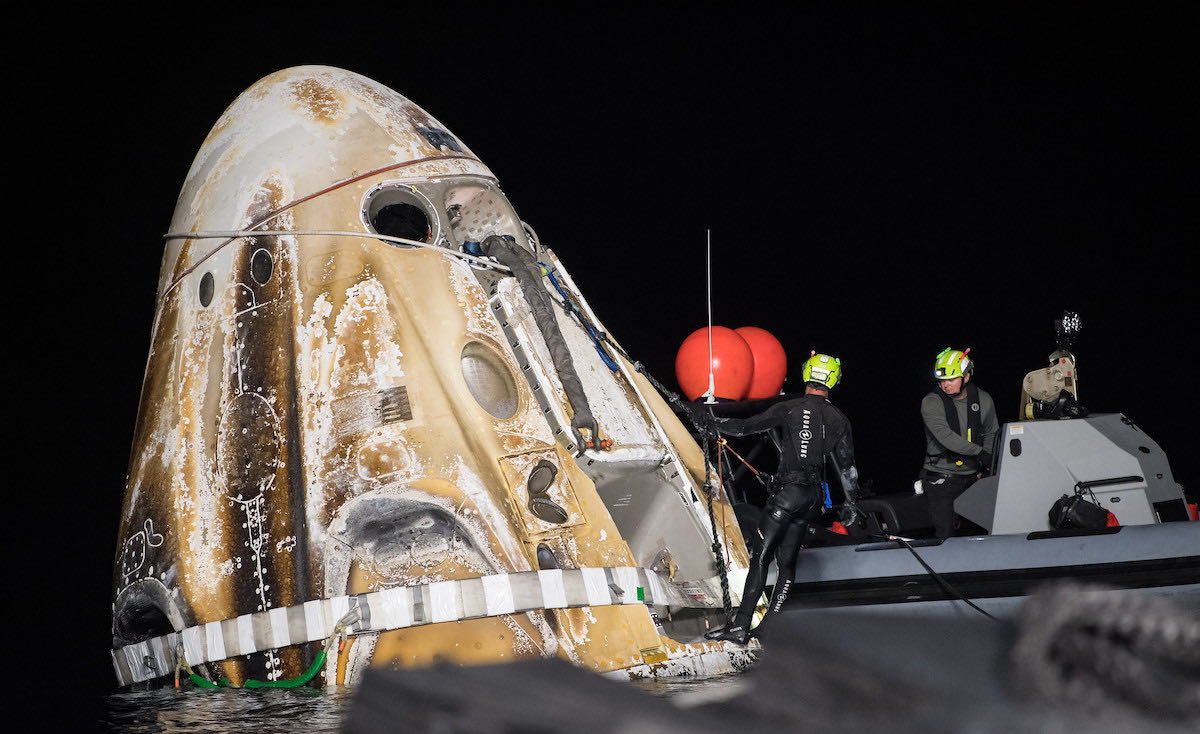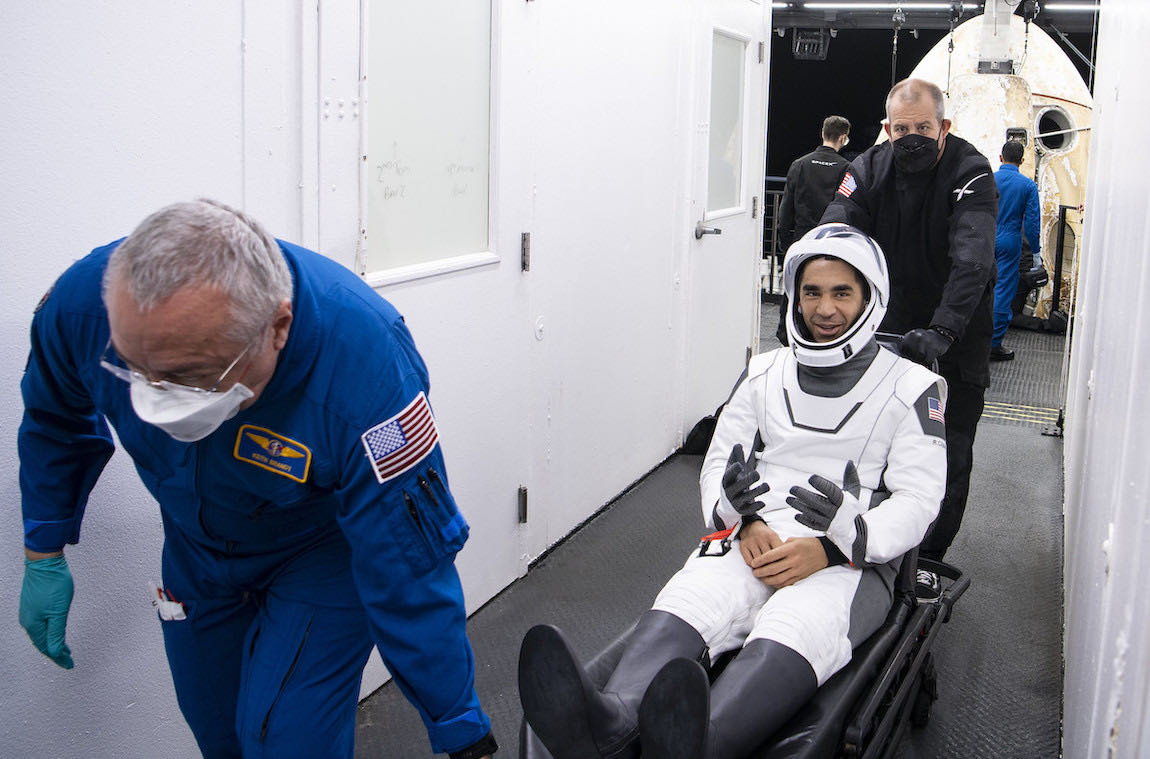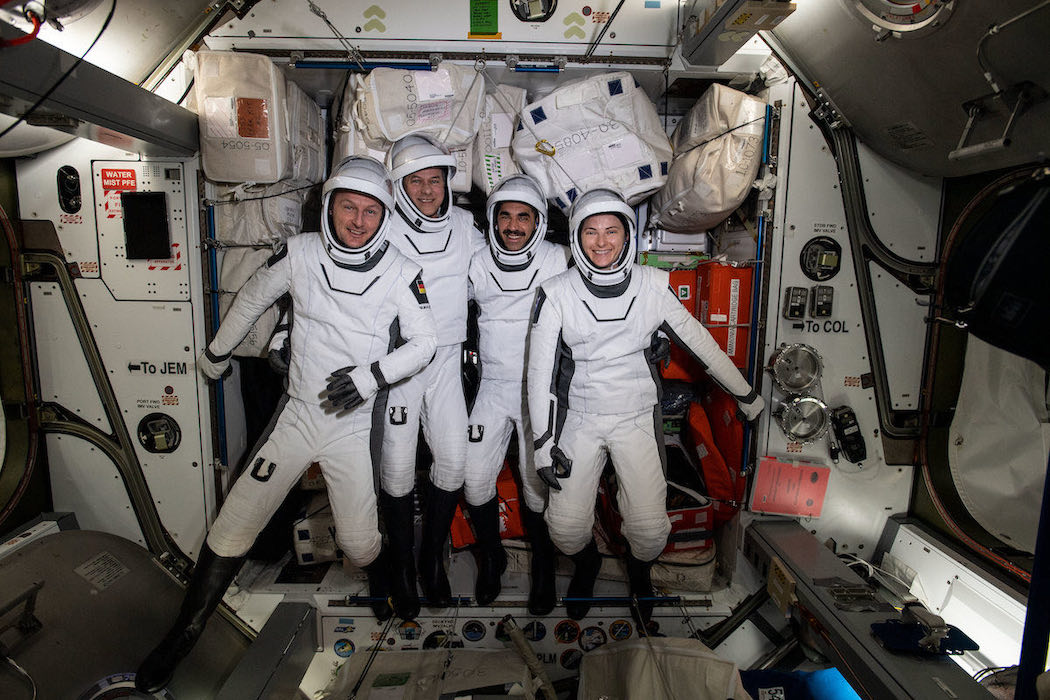
Four astronauts returned to Earth from the International Space Station early Friday with a parachute-assisted splashdown in the Gulf of Mexico off the coast of Florida, the sixth crew launch or landing in support of the station program in fewer than 50 days.
The splashdown of SpaceX’s Dragon Endurance spacecraft at 12:43 a.m. EDT (0443 GMT) Friday capped a 176-day mission for NASA commander Raja Chari, pilot Tom Marshburn, mission specialist Kayla Barron, and European Space Agency astronaut Matthias Maurer.
The mission, designated Crew-3, was the first flight of SpaceX’s Dragon Endurance spacecraft, the third of four human-rated Dragon capsules in SpaceX’s fleet.
“Thanks for letting us take Endurance on its shakedown cruise,” said Chari, a U.S. Air Force colonel and veteran fighter pilot. “Looking forward to watching many more flights of Endurance in the future. It was a great ride. Enjoyed working with the NASA and SpaceX teams. Thanks for getting us up to the space station and back safely.”
Chari, 44, made his first trip to space on the Dragon Endurance spacecraft. The Crew-3 mission was also the first spaceflight for Barron and Maurer, and the third for Marshburn, who has now flown on a space shuttle, a Russian Soyuz spacecraft, and a SpaceX Dragon vehicle.
The Crew-3 astronauts undocked from the space station at 1:20 a.m. EDT (0520 GMT) Thursday to begin a nearly 24-hour transit back to Earth. The Dragon Endurance spacecraft completed a series of burns to line up with the recovery zone off the coast of Tampa, Florida.
The capsule fired its Draco braking thrusters for nearly eight minutes to commit the spacecraft to re-entry. The Dragon Endurance spacecraft encountered the uppermost fringes of the atmosphere at 12:31 a.m. EDT (0431 GMT).
A tracking camera on a NASA WB-57 research aircraft shows the four main parachutes on SpaceX’s Dragon Endurance spacecraft have deployed as it descends toward the Gulf of Mexico.
Watch live: https://t.co/SBbgyLgfnI pic.twitter.com/S1er6dYMTQ
— Spaceflight Now (@SpaceflightNow) May 6, 2022
The build-up of super-hot plasma outside the capsule interrupted communications between the crew and mission control for about seven minutes, as expected. G-forces built up to several times the force of Earth’s gravity as friction from air molecules slowed the capsule from more than 17,000 mph to about 350 mph, when two drogue parachutes opened at an altitude of about 18,000 feet.
Less than a minute later, four main parachutes opened to slow the spacecraft to about 15 mph for splashdown in calm seas.
SpaceX’s recovery ship, named “Shannon” after NASA astronaut Shannon Walker, the first woman to fly on a Dragon spacecraft, pulled alongside the capsule and raised it from the ocean with a hydraulic lifting frame. Then SpaceX’s recovery team opened the Dragon hatch and helped the four astronauts out of their seats.
The astronauts were placed in recumbent seats as they got reacquainted to gravity for the first time in six months. All four crew members appeared happy and healthy, and NASA, ESA, and SpaceX medical personnel were aboard the ship for initial health checks on the astronauts.
The astronauts were expected to fly to shore on a helicopter, where a NASA jet was awaiting to carry the three NASA crew members back to their home base at the Johnson Space Center in Houston. An ESA airplane was scheduled to fly Maurer back o the European astronaut training center in Cologne, Germany.
Splashdown in the Gulf of Mexico confirmed at 12:43am EDT (0443 GMT).
SpaceX’s Dragon Endurance spacecraft and its four-person crew have returned to Earth after 176 days in space, covering 2,832 orbits and 75 million miles.https://t.co/SBbgyLgfnI pic.twitter.com/HIzrW0x7lG
— Spaceflight Now (@SpaceflightNow) May 6, 2022
The return of the Crew-3 astronauts Friday was the sixth launch or landing of a station crew since March 18, including two crew launches and two landings aboard SpaceX capsules.
Russia launched a team of three cosmonauts to the space station March 18 on a Soyuz spacecraft, followed by the undocking and landing of two cosmonauts and a NASA astronaut on a separate Soyuz mission March 30.
Then, on April 8, SpaceX launched four private astronauts on a Falcon 9 rocket and the Dragon Endeavour spacecraft on the first first fully commercial mission to the International Space Station. That flight, managed by a Houston company named Axiom Space, was commanded by retired NASA astronaut Mike López-Alegría.
Three Axiom customers, all wealthy businessmen, accompanied López-Alegría on the 17-day mission to perform experiments and public outreach events on the space station. The Axiom mission returned to Earth on April 25, and SpaceX launched the next long-duration crew mission for NASA — known as Crew-4 — from the Kennedy Space Center on April 27.
The Crew-4 astronauts, riding SpaceX’s Dragon Freedom capsule, docked at the station later the same day, joining the Russian cosmonauts and the Crew-3 astronauts on the outpost. The Crew-4 mission will remain at the station until September, when their replacements are scheduled to launch on SpaceX’s Crew-5 mission.
After a week-long handover, the Crew-3 astronauts packed their bags and prepared for their homecoming this week.

The Crew-3 mission launched Nov. 10 from Kennedy to begin the six-month expedition on the space station.
Marshburn, a 61-year-old medical doctor, ceremonially handed over command of the International Space Station crew to Russian cosmonaut Oleg Artemyev Wednesday, a few hours before departure.
“It’s been an interesting day for us,” Marshburn said. “We’ve been flying around the station, collecting our last minute photos, our last minute items, and getting ready to come home, so a bit of a bittersweet day for all of us.”
“I think, for all of us, it’s really hard to leave,” said Barron, U.S. Navy submarine officer before joining NASA’s astronaut corps. “We’re really looking forward to getting back to our families and our amazing support network on the ground.”
Maurer, a German materials scientist, said the highlights of his first space mission included the experiments, the launch, a spacewalk, and looking out the window to enjoy “the beauty of our planet Earth.”
Asked what he looked forward to upon return to Earth, Maurer replied he was excited to see family and friends, and enjoying the outdoors.
The Crew-3 mission was SpaceX’s third operational crew rotation flight to the space station for NASA. The crew was on-board the research outpost as diplomatic relations between the United States and Russia, the two most significant partners on the station, frayed in the aftermath of the Russian military invasion of Ukraine.
The fallout from the invasion led to the suspension of many cooperative spaceflight projects between Russia and Western countries, including Soyuz launch operations at the European spaceport in French Guiana, and the indefinite delay of the ESA-Russian ExoMars mission that was scheduled for launch later this year.
But work on the space station continued without interruption. The station requires key contributions from the U.S. and Russian segments to maintain operations.
“I think the lasting leagacy of the space station is very likely to be international cooperation and a place of peace,” Marshburn said has he handed over command to Artemyev. “Oleg, you’re a very strong and experienced cosmonaut. I know we’ll be leaving the space station in good hands with you.”
Artemyev arrived at the station in March with two Russian cosmonaut crewmates — Sergey Korsakov and Denis Matveev.
“We had a short period (together) … and now we’re brothers and sisters,” Artemyev told the Crew-3 astronauts. “What’s more important for me, for Sergey and for Denis, is our family, our children, peace between our countries, and our friendship. thank you for your friendship.”

In a press conference last month, Marshburn said he was looking forward to a hot bath after arriving back on Earth.
“I miss our planet,” he said. “I miss being tucked up under the clouds and feeling the rain that’s coming from above and feeling my toes in the sand, the grass.”
One of the highlights of the mission for Marshburn, a medical doctor and former NASA flight surgeon, was watching his fellow astronauts experience spaceflight for the first time.
“That’s been a hugely fulfilling and wonderful experience, having three crewmates,” he said. “They’ve gone from being rookies to veterans.”
Marshburn added that life aboard the space station was not directly impacted by the strained relations between Russia and Western nations on Earth.
“It’s been a very collegial, very friendly relationship together up here,” Marshburn said. “We really need each other for our survival. It is a dangerous environment, so we just go with our training, we go with recognizing that we are all up here for the same purpose, to explore, and to keep this space station maintained and to keep performing the science in our laboratories.
“So the dynamic hasn’t changed,” Marshburn said in response to a question from Spaceflight Now. “We have about a 40-year history of working with the Russians (in space), and that is all very much in work and play here.”
Email the author.
Follow Stephen Clark on Twitter: @StephenClark1.
